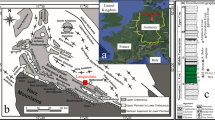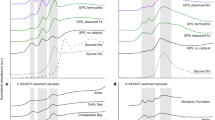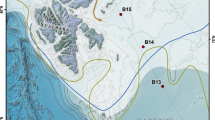Abstract
In much of the global ocean, iron is a limiting nutrient for marine productivity. The formation of pyrite has been considered the most important sink of reactive iron in modern, organic-rich sediments. However, clay mineral transformations can also lead to long-term sequestration of iron during late diagenesis and in hydrothermal settings. Here we present evidence for substantial iron sequestration during the early diagenetic formation of ferruginous clay minerals, also called green-clay authigenesis, in the deep-sea environment of the Ivory Coast–Ghana Marginal Ridge. Using high-resolution electron microscopic methods and sequential sediment extraction techniques, we demonstrate that iron uptake by green-clay authigenesis can amount to 76 ± 127 μmol Fe cm−2 kyr−1, which is on average six times higher than that of pyrite in suboxic subsurface sediments 5 m below the sea floor or shallower. Even at depths of 15 m below the sea floor or greater, rates of iron burial by green clay and pyrite are almost equal at ∼80 μmol Fe cm−2 kyr−1. We conclude that green-clay formation significantly reduces the pore water inventory of dissolved iron in modern and ancient pelagic sediments, which challenges the long-standing conceptual view that clay mineral diagenesis is of little importance in current biogeochemical models of the marine iron cycle.
This is a preview of subscription content, access via your institution
Access options
Subscribe to this journal
Receive 12 print issues and online access
$259.00 per year
only $21.58 per issue
Buy this article
- Purchase on Springer Link
- Instant access to full article PDF
Prices may be subject to local taxes which are calculated during checkout




Similar content being viewed by others
References
Martin, J. H. Glacial–interglacial CO2 change: The iron hypothesis. Paleoceanography 5, 1–13 (1990).
Martin, J. H. et al. Testing the iron hypothesis in ecosystems of the equatorial Pacific Ocean. Nature 371, 123–129 (1994).
Coale, K. H. et al. A massive phytoplankton bloom induced by an ecosystem-scale iron fertilization experiment in the equatorial Pacific Ocean. Nature 383, 495–501 (1996).
Blain, S. et al. Effect of natural iron fertilization on carbon sequestration in the Southern Ocean. Nature 446, 1070–1075 (2007).
Taylor, K. G. & Konhauser, K. O. Iron in earth surface systems: A major player in chemical and biological processes. Elements 7, 83–88 (2011).
Posth, N. R., Canfield, D. E. & Kappler, A. Biogenic Fe(III) minerals: From formation to diagenesis and preservation in the rock record. Earth Sci. Rev. 135, 103–121 (2014).
Poulton, S. W., Fralick, P. W. & Canfield, D. E. Spatial variability in oceanic redox structure 1.8 billion years ago. Nature Geosci. 3, 486–490 (2010).
Taylor, K. G. & Macquaker, J. H. S. Iron minerals in marine sediments record chemical environments. Elements 7, 113–118 (2011).
Raiswell, R. & Canfield, D. E. The Iron Biogeochemical Cycle Past and Present (Geochem. Perspec., 2012).
Köhler, I., Konhauser, K. O., Papineau, D., Bekker, A. & Kappler, A. Biological carbon precursor to diagenetic siderite with spherical structures in iron formations. Nature Commun. 4, 1741 (2013).
Berner, R. A. Migration of iron and sulfur within anaerobic sediments during early diagenesis. Am. J. Sci. 267, 19–42 (1969).
Canfield, D. E. Reactive iron in marine sediments. Geochim. Cosmochim. Acta 53, 619–632 (1989).
Raiswell, R. & Canfield, D. E. Sources of iron for pyrite formation in marine sediments. Am. J. Sci. 298, 219–245 (1998).
Poulton, S. W. & Raiswell, R. The low-temperature geochemical cycle of iron: From continental fluxes to marine sediment deposition. Am. J. Sci. 302, 774–805 (2002).
Elrod, V. A., Berelson, W. M., Coale, K. H. & Johnson, K. S. The flux of iron from continental shelf sediments: A missing source for global budgets. Geophys. Res. Lett. 31, L12307 (2004).
Jickells, T. D. et al. Global iron connections between desert dust, ocean biogeochemistry, and climate. Science 308, 67–71 (2005).
Raiswell, R. et al. Contributions from glacially derived sediment to the global iron (oxyhydr)oxide cycle: Implications for iron delivery to the oceans. Geochim. Cosmochim. Acta 70, 2765–2780 (2006).
Cassar, N. et al. The southern ocean biological response to aeolian iron deposition. Science 317, 1067–1070 (2007).
Homoky, W. B., John, S. G., Conway, T. & Mills, R. A. Distinct iron isotopic signatures and supply from marine sediment dissolution. Nature Commun. 4, 2143 (2013).
Johnson, K. S. et al. Surface ocean-lower atmosphere interactions in the Northeast Pacific Ocean Gyre: Aerosols, iron, and the ecosystem response. Glob. Biogeochem. Cycles 17, 1063 (2003).
Boyd, P. W. & Ellwood, M. J. The biogeochemical cycle of iron in the ocean. Nature Geosci. 3, 675–682 (2010).
Cumming, V. M., Poulton, S. W., Rooney, A. D. & Selby, D. Anoxia in the terrestrial environment during the late Mesoproterozoic. Geology 41, 583–586 (2013).
Parekh, P., Follows, M. J. & Boyle, E. Modeling the global iron cycle. Glob. Biogeochem. Cycles 18, GB1002 (2004).
Canfield, E., Poulton, S. W. & Narbonne, G. M. Late-Neoproterozoic deep-ocean oxygenation and the rise of animal life. Science 315, 92–95 (2007).
Poulton, S. W. & Raiswell, R. Chemical and physical characteristics of iron oxides in riverine and glacial meltwater sediments. Chem. Geol. 218, 203–221 (2005).
Canfield, D. E., Thamdrup, B. & Hansen, J. W. The anaerobic degradation of organic matter in Danish coastal sediments: Iron reduction, manganese reduction, and sulfate reduction. Geochim. Cosmochim. Acta 57, 3867–3883 (1993).
Severmann, S., McManus, J., Berelson, W. M. & Hammond, D. E. The continental shelf benthic iron flux and its isotope composition. Geochim. Cosmochim. Acta 74, 3984–4004 (2010).
John, S. G., Mendez, J., Moffett, J. & Adkins, J. The flux of iron and iron isotopes from San Pedro Basin sediments. Geochim. Cosmochim. Acta 93, 14–29 (2012).
Homoky, W. B. et al. Iron and manganese diagenesis in deep sea volcanogenic sediments and the origins of pore water colloids. Geochim. Cosmochim. Acta 75, 5032–5048 (2011).
Dale, A. W. et al. A revised global estimate of dissolved iron fluxes from marine sediments. Glob. Biogeochem. Cycles 29, GB005017 (2015).
Raiswell, R. Iceberg-hosted nanoparticulate Fe in the Southern Ocean: Mineralogy, origin, dissolution kinetics and source of bioavailable Fe. Deep Sea Res. I 58, 1364–1375 (2011).
Passier, H. F., Middelburg, J. J., de Lange, G. J. & Böttcher, M. E. Pyrite contents, microstructures, and sulfur isotopes in relation to formation of the youngest eastern Mediterranean sapropel. Geology 25, 519–522 (1997).
Chester, R. Marine Geochemistry (Blackwell Science, 2000).
Baldermann, A., Warr, L. N., Grathoff, G. H. & Dietzel, M. The rate and mechanism of deep-sea glauconite formation at the Ivory Coast—Ghana Marginal Ridge. Clay. Clay Miner. 61, 258–276 (2013).
Charpentier, D., Buatier, M., Jacquot, E., Gaudin, A. & Wheat, C. G. Conditions and mechanism for the formation of iron-rich montmorillonite in deep sea sediments (Costa Rica margin): Coupling high-resolution mineralogical characterization and geochemical modeling. Geochim. Cosmochim. Acta 75, 1397–1410 (2011).
Mascle, J. et al. 9. Principal results. Proc. ODP Init. Rep. 159, 297–314 (1996).
Giresse, P., Gadel, F., Serve, L. & Barusseau, J. P. Indicators of climate and sediment-source variations at site 959: Implications for the reconstructions of paleoenvironments in the Gulf of Guinea through Pleistocene times. Proc. ODP Sci. Res. 159, 585–603 (1998).
Wagner, T. Pliocene–Pleistocene deposition of carbonate and organic carbon at Site 959: Paleoenvironmental implications for the eastern equatorial Atlantic of the Ivory Coast/Ghana. Proc. ODP Sci. Res. 159, 557–574 (1998).
Johnson, K. S., Coale, K. H., Elrod, V. A. & Tindale, N. W. Iron photochemistry in seawater from the equatorial Pacific. Mar. Chem. 46, 319–334 (1994).
Berner, R. A. Burial of organic carbon and pyrite sulfur in the modern ocean: Its geochemical and environmental significance. Am. J. Sci. 282, 451–473 (1982).
Logvinenko, N. V. Origin of glauconite in the recent bottom sediments of the ocean. Sediment. Geol. 31, 43–38 (1982).
Poulton, S. W., Krom, M. D. & Raiswell, R. A revised scheme for the reactivity of iron (oxyhydr)oxide minerals towards dissolved sulfide. Geochim. Cosmochim. Acta 68, 3703–3715 (2004).
Odin, G. S. Green Marine Clays (Elsevier, 1988).
Giresse, P., Wiewióra, A. & Grabska, D. Glauconitization processes in the northwestern Mediterranean (Gulf of Lions). Clay Miner. 39, 57–73 (2004).
Wigley, R. A. & Compton, J. S. Oligocene to Holocene glauconite phosphorite grains from the Head of the Cape Canyon on the western margin of South Africa. Deep Sea Res. II 54, 1375–1395 (2007).
Thompson, G., Mottl, M. J. & Rone, P. A. Morphology, mineralogy and chemistry of hydrothermal deposits from the Tag Area, 26° N Mid-Atlantic Ridge. Chem. Geol. 49, 243–257 (1985).
Buatier, M., Honnorez, J. & Ehret, G. Fe-smectite–glauconite transition in hydrothermal clays from the Galapagos Spreading Center. Clay. Clay Miner. 37, 532–541 (1989).
Cuadros, J., Dekov, V. M., Arroyo, X. & Nieto, F. Smectite formation in submarine hydrothermal sediments: Samples from the HMS Challenger Expedition (1872–1776). Clay. Clay Miner. 59, 147–164 (2011).
Raiswell, R. et al. Formation of syngenetic and early diagenetic iron minerals in the late Archean Mt. McRae Shale, Hamersley Basin, Australia: New insights on the patterns, controls and paleoenvironmental implications of authigenic mineral formation. Geochim. Cosmochim. Acta 75, 1072–1087 (2011).
Van Aken, P. A., Liebscher, B. & Styrsa, V. J. Quantitative determination of iron oxidative states in minerals using Fe L2,3-edge electron energy-loss near-edge structure spectroscopy. Phys. Chem. Miner. 25, 323–327 (1998).
Baldermann, A. et al. The Fe–Mg-saponite solid solution series—A hydrothermal synthesis study. Clay Miner. 49, 391–415 (2014).
Acknowledgements
The authors acknowledge A. Wuelbers from the MARUM Bremen, who assisted us with the sampling. M. E. Böttcher from the Baltic Sea Research Institute (IOW, Warnemünde) is greatly acknowledged for his support with the solid phase iron speciation calculations and he provided the bulk sediment sulphur data. Funding by the NAWI Graz is highly appreciated.
Author information
Authors and Affiliations
Contributions
A.B. and L.N.W. wrote the manuscript. A.B. provided the solid phase iron speciation data and A.B. and V.M. calculated the iron sequestration rates. I.L.-P. provided the TEM data. V.M. and I.L.-P. contributed to the preparation of the manuscript.
Corresponding author
Ethics declarations
Competing interests
The authors declare no competing financial interests.
Supplementary information
Supplementary Information
Supplementary Information (PDF 503 kb)
Rights and permissions
About this article
Cite this article
Baldermann, A., Warr, L., Letofsky-Papst, I. et al. Substantial iron sequestration during green-clay authigenesis in modern deep-sea sediments. Nature Geosci 8, 885–889 (2015). https://doi.org/10.1038/ngeo2542
Received:
Accepted:
Published:
Issue Date:
DOI: https://doi.org/10.1038/ngeo2542
This article is cited by
-
Impact of green clay authigenesis on element sequestration in marine settings
Nature Communications (2022)
-
Authigenic clay mineral evidence for restricted, evaporitic conditions during the emergence of the Ediacaran Doushantuo Biota
Communications Earth & Environment (2022)
-
Characterization of Iron-Rich Phyllosilicates Formed at Different Fe/Si Ratios
Clays and Clay Minerals (2022)
-
Removal of heavy metals (Co, Cr, and Zn) during calcium–aluminium–silicate–hydrate and trioctahedral smectite formation
Journal of Materials Science (2019)
-
Reverse weathering as a long-term stabilizer of marine pH and planetary climate
Nature (2018)



